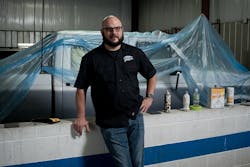It wasn’t too long ago when FenderBender caught up with Tennessee shop owner Cam Mashburn. In January 2017, the owner of Mashburn Collision Center shared his journey from switching career paths—well, switching industries entirely—to help his dad’s shop gain momentum when it came to cycle time.
The now-seasoned owner can say he knows how to run an effective business. In 2017, sales were up by $110,000 over the previous year, putting the shop at an annual revenue of $1.6 million. Better yet, his shop’s cycle time is now at 4.2 days (to read more about Mashburn’s story, visit fenderbender.com/gatheringspeed).
When asked how he’s been able to consistently grow in his market, Mashburn didn’t just attribute his knowledge to constantly educating himself through trade magazines and all other material he could get his hands on. Instead, always implementing small, incremental ways to better his processes has been one of many factors that has helped him grow along the way.
Keep Up to Date
As the business began growing, Mashburn says he quickly realized he couldn’t continue doing things the old way, where there was no rhyme or reason as to why things were getting done the way they were.
In an effort to improve processes in the shop, Mashburn says that always implementing new ideas or ways to ease processes not only leads to a happier staff, but also aids in turning a profit and staying ahead.
“You have to constantly be improving or the industry will pass you by,” Mashburn says.
While it does not directly correlate with attracting new customers, he says it has helped streamline processes in his shop, and helped his employees do their jobs faster, in turn resulting in improved cycle time.
If you’re not quite sure where to start or what to implement, Mashburn says that visiting shops outside of your market can help tremendously, especially shops that affiliate with the same paint company, as your processes may be similar, making it easier to relate.
Make Things Easier
Mashburn is always implementing new ideas. Here are a few things that he’s done recently to improve his operation:
- Tablets and Computers. All of the techs on the floor now have access to brand new tablets and computer workstations to improve efficiency. There are now four tablets and three computers on the shop floor, and each tech gets his or her own login information. Mashburn says that as repairing to OEM specifications becomes more important, he wants to make it easier for his techs to look up OEM information.
- Tracking Finances. Instead of doing things the old-fashioned way, Mashburn uses QuickBooks to write checks.
- Scheduling. Mashburn created his own scheduling system using Google Drive. It’s a spreadsheet with all of the techs’ names and the jobs scheduled for the day listed out. It is free and can be easily shared among the office staff.
- Organizing Jobs. Instead of jobs being referred to by the customer’s last names (that wasn’t even specified on any shipping label), now every job is attached to an RO number.
Employee Buy-In
Employee buy-in is the toughest thing to achieve, Mashburn says. You have to remember that “you can’t implement a completely new idea, you have to do it slowly.”
If you can’t convince your staff how a new idea is meant to work and make things better, it simply won’t pan out. Take things slow and talk to your staff members both individually and as a team.
Mashburn has a senior tech that can sometimes be the hardest to convince, but when he participates in something, the rest of the team follows. Start with the leaders of your team.
Here are some more of his tips for implementing new ideas in the workplace:
- Take it small. Don’t create multiple big projects to implement. Keep things manageable.
- Don’t expect perfection to happen overnight.
- Give things a fair shake. Don’t just try new things out and get discouraged if they don’t work for one job or one week. Keep trying.
- If it’s the right way to go, stick with it and be patient.

